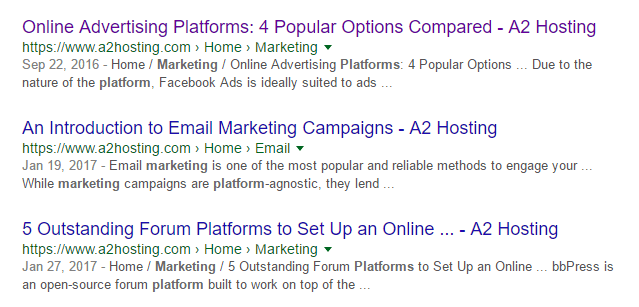- Feb 28, 2017
 0
0- by A2 Marketing Team
It takes money to make money, or so the saying goes. When it comes to advertising, a huge budget can certainly help, but you can also get a lot done without one.
There are plenty of ways to get your online business the attention it deserves without breaking the bank. The key is to think outside the box and take advantage of every element at your disposal – from social media platforms to word of mouth.
In this article, we’ll explore four ways to stretch a shoestring budget for optimal results, why they work, and how to implement them. Put away your piggy bank and let’s get started!
1. Optimize for Search Engines
Search Engine Optimization (SEO) is the science of making your online content more appealing for platforms like Google and Bing. Our use of the word “science” is deliberate, since there are dozens of elements that influence your ranking in search engine results pages, and the list is always evolving.
Getting acquainted with SEO best practices can be intimidating for new online marketers, but it can be one of the best ways to promote your products or services. Optimizing your content for search engines enables you to tap into a long-term source of organic traffic. This means more users will be able to find you on their own, rather than through advertisements that you have to pay for.

When thinking about SEO, the first element that often springs to mind is keywords. However, there are many more components to consider. To have the best chance of ranking highly, you need to work on other content elements, such as meta tags, image tags, and internal and external links.
Moreover, many factors that are commonly associated with making your site user-friendly can also have an impact on SEO. Think easy-to-use navigation, fast loading pages, and being mobile-friendly. Improving the user experience not only boosts SEO, but also helps to keep visitors on your site, and hopefully increase conversions!
2. Work on Obtaining Positive Reviews
Word of mouth is a powerful thing, and online reviews are one of the best ways for users to share their thoughts about your services with others.

Of course, it’s impossible to fully control the types of reviews that customers leave you. However, as long as you focus on providing an outstanding service, you shouldn’t have anything to worry about.
You don’t need to accumulate dozens of reviews for them to have an effect on conversions. It has been demonstrated that most online users trust reviews over other forms of marketing, which means even a few can go a long way.
Copying and pasting reviews to publish them on your site is easy, but ideally, you’ll want to set up a way for customers to submit them automatically. WordPress users can do this using a plugin such as Rating-Widget, which works seamlessly with WooCommerce products:

Another good option is to keep your reviews separate from your main site using a platform like Yelp. This particular service enables you to embed your latest reviews on any website, so you get the best of both worlds.
3. Exploit ‘Virality’ in Social Media
Viral social media posts are an interesting byproduct of the accessibility and popularity of instant online sharing. While there are no specific numbers of shares, likes, or views that define a ‘viral’ post, you’d generally expect to see one shared thousands (if not millions) of times.

If you know how to grab people’s attention and get lots of them to share your content, the exposure can be enough to send a massive volume of traffic to your website. Some of those visitors might decide to return later, and may even convert to full-fledged customers.
The main problem with relying on social media virality is that there is no magic formula to help you predict which content will hit it big. However, there are a couple of techniques you can employ to increase your chances.
For example, long-form content is doing well these days, and tends to be shared more often than shorter pieces. Coming up with attention-grabbing headlines is also a great place to start, since these can help to increase your click-through rate.
As we mentioned earlier, relying on virality to promote your website is a bit of a long shot, but that doesn’t mean it’s not worth considering. While it’s probably best not to focus all of your content efforts on trying to ‘go viral’, you could optimize the occasional piece for virality and see how it performs.
4. Develop Targeted Advertising Campaigns
So far, we’ve focused on marketing techniques that require almost no investment beyond your time. However, we’d be remiss if we didn’t point out that you can take advantage of traditional advertising campaigns, even with a modest budget. For example, Facebook Ads enable you to apply specific targeting with a low minimum spend.

If you’re new to online marketing, and haven’t had the opportunity to run a campaign, here’s why you should consider it:
- Precision. All the techniques we’ve covered so far work well enough to get you more traffic and conversions, but they can’t target specific subsets of users.
- Analytics. Most major marketing platforms provide you with a wealth of data on the performance of your campaigns, which enables you to optimize your approach.
- Flexibility. An online marketing campaign can be as big or as small as you want – you decide how much to spend and when to do it.
Before you jump into the world of online advertising, we recommend that you set a budget and stick to it. Once you have a figure in mind, it’s time to learn the ins and outs of advertising, and decide which platform to start with.
Conclusion
When it comes to online marketing, you don’t need to break the bank in order to start seeing positive results. The methods we covered in this article may not turn your website into a massive success overnight, but over the long term, they’ll enable you to build a decent following without investing too much money.
Before we wrap up, let’s briefly recap the four marketing techniques we covered earlier:
- Optimize for search engines.
- Work on obtaining positive reviews.
- Exploit virality in social media.
- Develop targeted advertising campaigns.
Image credit: Pixabay.










